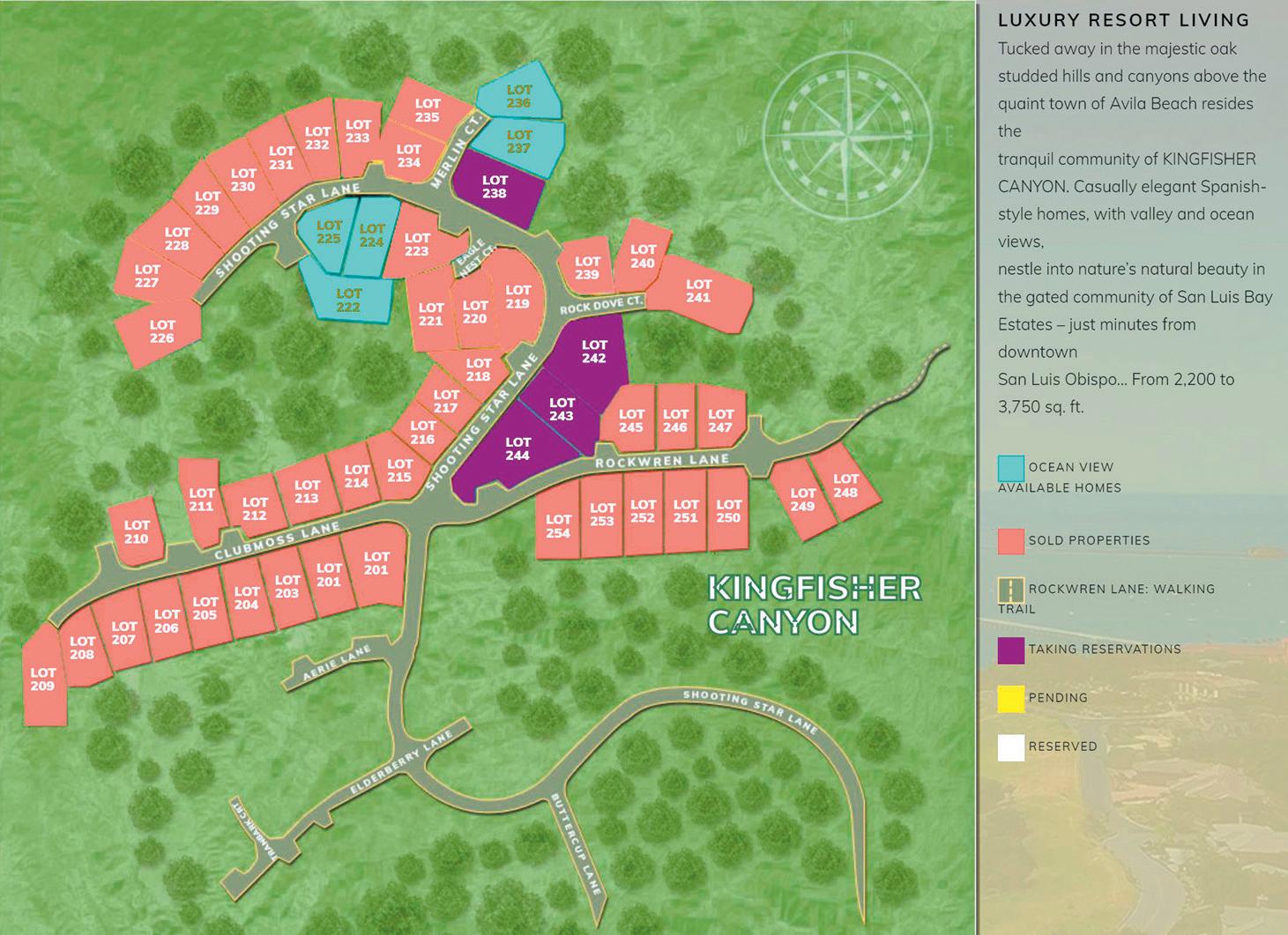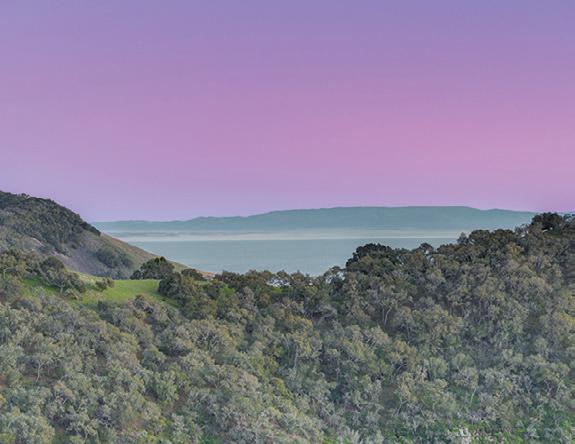Unpredictable Events of Nature



See Page 6

Contributors
Mary Foppiano
Betty Hartig
Kathy Mastako

Rick Cohen
John Salisbury
Jennifer Sacles




See Page 6

Mary Foppiano
Betty Hartig
Kathy Mastako

Rick Cohen
John Salisbury
Jennifer Sacles

Being a part of a small hometown community is a truly special experience. It means knowing the names of your neighbors, recognizing familiar faces in town, and feeling a sense of belonging. Living in a small town offers a unique opportunity to build long-lasting relationships, get to know your neighbors, and contribute to a supportive community that believes in the well-being of all its members.
San Luis Obispo County is a perfect example of a place where small-town charm and a close-knit community meet the beauty of nature. Whether it’s enjoying a morning hike on a local trail, taking a stroll on the beach, or admiring the wildflowers in the springtime, there’s something for everyone.



But living in a small town isn’t just about enjoying the natural beauty and charm. It’s about the people who make up the community. Small towns offer a unique opportunity to come together and support one another, whether it’s rallying around local causes or showing up for our neighbors in times of need.
One of the most important ways we can support our community is by shopping local and supporting small businesses. Small businesses are the backbone of our local economy and help to create jobs, generate revenue, and bring unique character to our town. By choosing to shop local, we can keep our dollars within our community and contribute to the growth and prosperity of our hometown.
Raising our kids in SLO County provides an environment where they are surrounded by people who genuinely care about their well-being and growth. Neighbors become family, and everyone looks out for one


another. It’s a place where kids can be kids and have the freedom to run around and play outside without parents constantly worrying about their safety.
Taking pride in our community means doing our part to keep it beautiful and thriving. This includes volunteering for local events and organizations, participating in community clean-ups, and being a good neighbor. We can also work to preserve the history and unique character of our town by supporting local museums and historical sites.
Living in a small-town community means being a part of something bigger than ourselves. It means taking care of our neighbors, preserving our natural beauty, and working to keep our unique character alive. This lifestyle brings a sense of fulfillment and happiness to our lives.
Let’s continue to take pride in our hometown and do our part to support the community. Thank you for shopping local, volunteering, and being good neighbors. Together, we can keep the charm and beauty of the SLO County alive for generations to come.
telling you about for the last few months.
Rick Cohen avila beach foundationGreetings, fellow Avilones. As most of you know, the main function of the Avila Beach Community Foundation is to issue grants that improve the quality of life in Avila Beach. This includes support to local nonprofit and public agencies that offer services or provide community enhancement projects. Each of our grantees is required to report back to the Foundation at the end of the year the results of their work related to our funding. This month I will share with you some feedback from one of our 2022 grantees that I think you will find interesting. But first, here’s some news about an upcoming special event I have been

Mark your calendar for our “History of Front Street” presentation, scheduled for March 30. Local historian Pete Kelley will be sharing some wonderful old-time slides along with a narrative of life in Avila Beach going back many decades. This event — which is free and by invitation only, is being held at the Avila Beach Community Center, from 6:30 to 8 p.m. No dinner is being served, but dessert is on us. The Civic Association will offer beer and wine for those wishing to purchase an adult beverage. Those of you who presently subscribe to the Foundation’s e-newsletter will receive electronic invitations to the event. Attendance will be limited to the first 70 people who respond to the invitation. Those of you who only receive the Avila Beach Life print news publication can request an invitation by sending an email to avilabeachcf@gmail.com. We look forward to seeing you on the 30th.
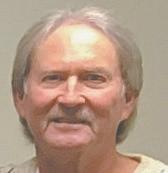
Now, getting back to my opening paragraph, I am pleased to tell you a little about one of our grantees, the Cancer Well-Fit program, held at the Avila Bay Athletic Club. CWF provides its no-cost wellness program
to men and women in our community in varying stages of cancer. Over the years CWF staff has shared with the Foundation some of the comments they receive from grateful program participants. This feedback tells the story of just how important the program has been in enabling their ability to resume a healthy life. Following are just some of the comments included in the last CWF yearend grant report:
“I did not know what to expect from the program but really wanted to transition from fatigue, weakness and fragility of treatment’s side effects to a more “normal” life. The program helped me meet these desires very well/excellently. I increased my stamina, endurance and strength. Under supervision, I was able to return, physically and emotionally, to better fitness and to re-enter society.”
“I looked forward to being with others in like situations, and this program provides camaraderie with other cancer patients. I experienced openness, support and the generosity of our local community through this helpful program.”
“I needed structure and motivation to get moving again after surgery and six weeks
of radiation. This program was excellent! I loved the introduction to TRX training. Both trainers were kind, patient and supportive/ flexible. I looked forward to seeing the other participants.”
“I was clueless about what to expect when we started the program. My desire was to increase my energy, strength and endurance. My desires were met 100 percent. I looked forward to swimming after our group workouts and having muscle fatigue. I would like to suggest that receiving nutrition information as part of this program would be very helpful.”
This from CWF Executive Director Jan Secord and Program Director Danielle Lien: “On behalf of our Cancer Well-fit team of compassionate and caring instructors, we thank all of you at the Avila Beach Community Foundation for your continued support. Your vote of confidence in us and the funding you provide allow us to continue to provide this helpful program for our neighbors.”

The Foundation is proud to help make such a huge difference through our support. That’s it for now, fellow Avilones. See you at the beach!
During the years 2016—2021, investing was characterized by 2 acronyms—”FOMO” and “TINA.” FOMO— ”Fear Of Missing Out”—caused investors to buy every dip in the stock market. Those years were filled with market drops that were immediately bought. The old cliché that the markets drop like an elevator and rise like an escalator didn’t apply.
This behavior was propelled by TINA—”There Is No Alternative.” TINA was the rational for the FOMO attitude. The idea was that, with interest rates at historical lows over that time period, investing in bonds or CDs or cash were not realistic alternatives. With little competition, stocks soared to heights and valuations here to-fore unseen in modern markets.
Now, everything has changed and we have “JOMO,” - “Joy Of Missing Out.” The 2022 stock/bond market drops were, in my opinion, largely a result of rapidly rising interest rates. “Suddenly” there was/is competition for stocks, especially riskier stocks that take a long time to potentially pay off. For the first time in 16 years, money market accounts, short term T-bills and notes, and most bonds now pay north of 4%. People are “joyful” to miss out on the gyrations of the stock and long bond markets.
Maybe it’s time to look at some new/old ideas. Perhaps 5+% on fixed accounts and stock market strategies protecting as much as 20% to the downside^ would put some joy into your investing world? To learn more, please visit our website and/or call for a 15 minute discussion.

Iknow that you are all just sitting on the edge of your seats waiting to see the winners of our Cupid Paws Doggie Parade on February 4. However, you will need to wait until next month’s column to see the pictures and hear all the details of this fun event since I wanted to tell you about an event that I know you have been looking forward to attending. The COVID pandemic shut down the Community Center for much of the past few years … but we now are happy to announce our annual Spaghetti Dinner/Bingo Night being held on Friday, April 14, from
6 to 8:30 a.m. The dinner will consist of delicious spaghetti and meatballs, spaghetti and marinara sauce, salad, bread, and dessert. We will have soft drinks and beer and wine for sale. There will be a wide variety of bingo prizes for all age groups. I will give you more information next month but hope that you will put April 14 on your calendar now so that you can join us for this family fun night! If you are interested in getting involved with this event or any other upcoming events, please contact me at avilabeachcc@gmail. com or (805) 627-1997.
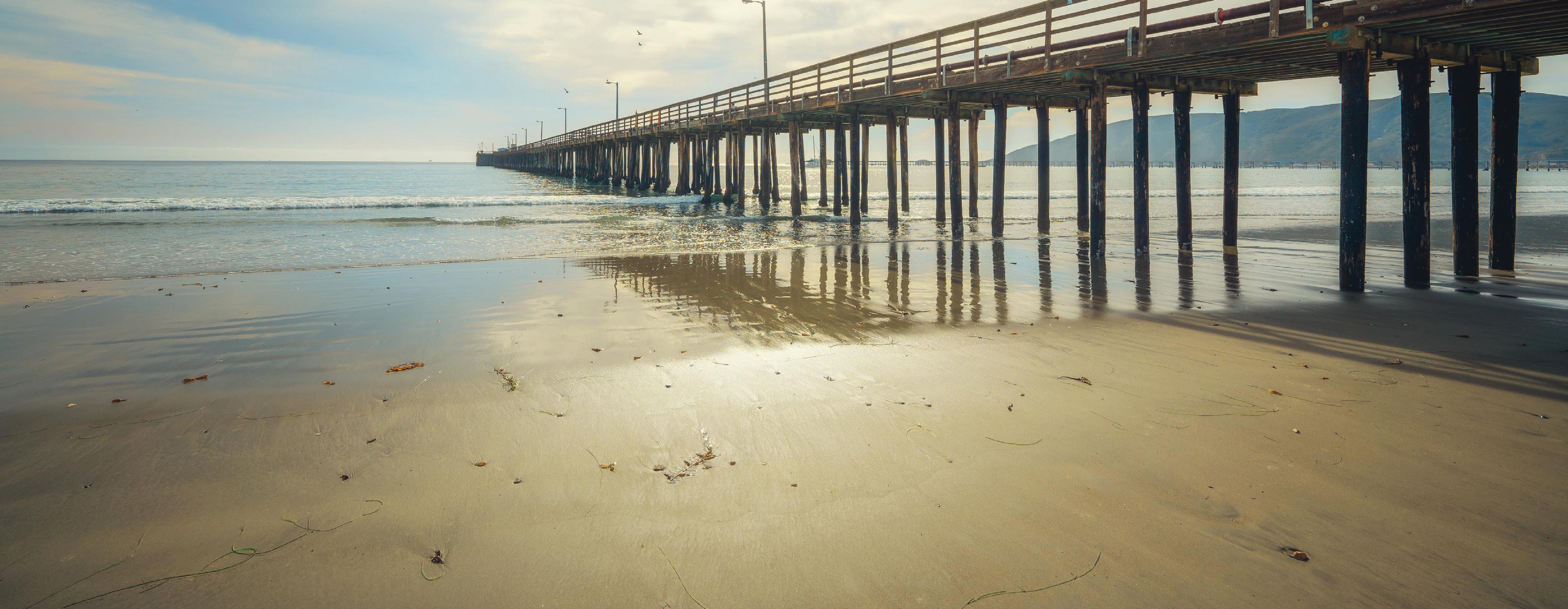
The Central Coast Aquarium (CCA), a 501(c)(3) nonprofit organization, was founded in 1994 in Avila Beach, when local residents Russel and Carol Kiessig realized their passion for marine science education. Their vision was to create an opportunity for everyone, but especially children, to learn about marine science in an exciting, hands-on environment that would promote an interest in science and a dedication to ocean stewardship.
The Central Coast Aquarium is the only organization in our region to provide interactive marine science education for grades K-12. They meet this need with diverse, engaging programs that reach a broad array of students. The students who attend their programs come primarily from SLO County, but they also service schools in Kern, Fresno, and Santa Barbara Counties. In 2022, their school programs involved over 3,000 students.

Central Coast Aquarium is rooted in community involvement. They are supported and carried by their volunteers who generously donate their time to help their mission succeed. They are situated in the heart of Avila Beach where locals and tourists can walk through their doors and receive an immersive aquarium experience. They believe the best way to achieve their mission of creating a community dedicated to ocean stewardship is to create impactful and meaningful ways for all members of their community to connect with the ocean and its inhabitants. To achieve these goals, they currently offer school programs, camps, lectures, and a public aquarium with local marine species. They engage in community
outreach events including beach cleanups and school, library, and state fair outreach events. Since the beginning of their organization in 1994, their education program has successfully taught over 26,000 students from seven counties and 1,400 summer campers. In addition, nearly 88,000 visitors have visited their aquarium exhibit hall. They have twenty-eight years of educational experience that they intend to utilize to carry their mission forward and their staff is excited and keen to continue working with their local community and implement new programs and projects.
This past September, Rebecca Creighton came on as their Director of Animal Husbandry and they couldn’t be more excited to have her! Rebecca hails from beautiful southern Maryland where she grew up raising livestock on her family’s small hobby farm. A proud alumnus of
University of Maryland, she earned her bachelor’s degree in agricultural science and technology in 2015. After pursuing a career in agriculture communications, she left her desk job to join the Peace Corps as an agriculture extension agent in Madagascar where she discovered an amazing culture. After returning from service, she pursued her dream of working in the marine science field and served as an educator at an aquarium, as an endangered species observer on dredge ships, as a coral restoration biologist, and as a PADI divemaster until she decided to move to California to work for the Central Coast Aquarium. Rebecca is responsible for the wellness, feeding, and care of all aquatic animals in the aquarium. Specific responsibilities include, but are not limited to, scheduling and management of animal feeding and care, tank/ habitat upkeep, tank maintenance, and the
collection and assimilation of new animals. Rebecca assists with educational programs, exhibit hall tours, and public feedings. This past October, Jaclyn Mann started as their Director of Programs and Education.

Jaclyn grew up down the 101 in Ventura, CA. She graduated from Cal Poly, SLO in 2011 with her B.S. in Biological Sciences and a minor in Environmental Sciences. After a gap year, she moved down to Long Beach for graduate school at Cal State University, Long Beach. While in Long Beach, she trained to become a PADI scuba instructor while also completing internships for wetlands restoration and biological monitoring. She worked for the Long Beach Marine Institute as a marine science educator for over 3 years, gaining valuable science education experience while teaching locally and on Catalina Island. Upon completion of her program, she graduated with an M.S. in Biological Sciences as a part of Dr. Bengt Allen’s Marine Ecology Lab. Jaclyn jumped at the opportunity to return to the Central Coast and join the aquarium’s staff. She is responsible for the planning and execution of all the aquarium’s educational programs. Under her leadership, Jaclyn works with volunteers to help facilitate their programs including outreach events, school and library visits, discovery labs at the aquarium, exhibit hall tours, and lectures. Join them for a fun-filled week (March 27-31) of hands-on marine science experiments, dissections, crafts, and games! Each day their campers will learn about the marine life and ecosystems that make up the world’s oceans. Activities will cover topics like Marine Mammals, Tide Pooling, Sharks and Rays, Ocean Conservation, Animal Adaptations, and Swashbucklers of the Past. To register or for more information, please contact Jaclyn Mann at jaclyn@ centralcoastaquarium.org or (805) 457-5357.

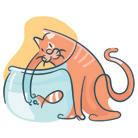 By MARY FOPPIANO
By MARY FOPPIANO
Karen Blue found Dakota on Pet Finders in Fresno. She had family view her at Petco and had the Sake of Dogs Rescue hold her until she made the drive. Karen and Zoey (Dakota’s adopted name) were able to enjoy their thirteenth anniversary on
Super Bowl weekend still together. Zoey loves living in Avila Beach and looks forward to her daily walks, doggie treats, and constant compliments on how cute she is. So, it comes as no surprise that she has entered several doggie parades and won a few awards!

After nearly 133 years, the lighthouse at Point San Luis finally has a book about its history. (Full disclosure: the author of this article is the author of the book.) “The Lighthouse at Point San Luis, A collection of short (true) stories” was published under the United States Lighthouse Society imprint, using Amazon’s print-on-demand platform.
To quote from the book’s introduction, “it’s a collection of tales — true tales, not tall tales — mainly about the people who lived and worked at the lighthouse during the late nineteenth and early twentieth centuries. The last chapter covers a later period, with stories about the young military men and their families stationed at the lighthouse during the twentieth century’s middle years.”
The book starts with a story about the building of the lighthouse, and the hapless contractor who, plagued by a recordbreaking rainy season and a hard-toplease lighthouse service official, finished the job nearly five months after the completion date specified in his contract. As a consequence, the government held back $3,737.50 from the $18,893 he was owed for the job — a $25 per day forfeiture imposed for late delivery. To add insult to injury, he unwittingly underbid the job. For example, he claimed he was told he could land building materials on the beach below the building site. This proved impossible. Instead, he was forced to build a wharf, tramway, and lighter at his own expense to unload lumber, bricks, and other supplies. He tried several times to convince the government to rescind its financial penalty, as did his daughter after his death, but the government proved intransigent.
Captain Henry Wilson Young is the subject of another story. Young was principal keeper at Point San Luis for 15 years, from its start in 1890 until 1905. What isn’t in the story, though, is his first impression of the destruction caused by the 1906 San Francisco earthquake and fire. Young had transferred from Point San Luis to the Alcatraz Island light the previous


November. On April 18, 1906, he wrote in his logbook, “5:30 A.M. Violent and continuous earthquake. San Francisco on fire. Is this the end of the world? Terrible seeing S.F. from here.”
Antonio Souza served with Captain Young for ten years, first as second assistant and then, after four years, as first assistant. The story about Souza recounts a falling-out between Keeper Young and his subordinate in early 1900, although ill will between the two men most likely started earlier. Against orders, Souza had sawed some branches off “two of the most important trees on this station,” disfiguring them, according to Young. Much worse, though, was Young’s claim that Souza had insulted and humiliated Young’s wife and, by extension, Young himself.
As the Keeper wrote to Uriel Sebree, the 12th district inspector, “We have always had the respect of the people about us. What must they think now, after such a scene, if I don’t report him and have him punished.”
The book also has stories about the other four principal keepers — William J. Smith, George Watters, Fred Saunders, and Bob Moorefield — and about the station’s longest serving assistant keeper Antonio J. Silva. Interspersed with these accounts are stories about the station’s fourth order Fresnel lens, the rescue of the only three survivors from the ill-fated Roanoke, the keepers’ children and the schools they attended, and how the keepers and their families celebrated the holidays.
The last chapter — the book’s longest chapter — recounts the memories of many Coast Guardsmen and their family members stationed at Point San Luis during the 1940s, ’50s, ’60s, and ’70s before the station was fully automated and left unmanned in December 1975.
The history of the lighthouse is also recounted through numerous photographs — some from the National Archives and others from private collections used by special permission, like a circa 1905 photo of Christmas dinner inside the keeper’s
dwelling at Point Sur and a circa 1955 image of the no-longer-standing Pecho Adobe.
The book is available on Amazon and from the outlets like the Point San Luis Lighthouse, Morro Bay Maritime Museum, Santa Barbara Maritime Museum, the San Luis
Obispo County History Center, and the South County Historical Society. Proceeds benefit the United States Lighthouse Society and the Point San Luis Lighthouse Keepers, two non-profits dedicated to preserving lighthouse history.
One Cool Earth is pleased to announce the award of a substantial grant from the National Oceanic and Atmospheric Administration (NOAA) Marine Debris Program to implement a curriculum on marine debris prevention. This grant provides funding for education on waste and litter management, composting, and the flow of watersheds in the area.
Starting on March 13, the organization will begin its Zero Waste Week, facilitating campus-wide waste audits and waste education lessons in schools across San Luis Obispo and Northern Santa Barbara counties. Students in these audits
will develop their knowledge about local watershed stewardship and proper waste and composting procedures. This is in accordance with One Cool Earth’s Marine Debris Prevention Manual, which is available alongside other educational resources on its website.
One Cool Earth’s program brings together an alliance of nonprofits, public schools, indigenous groups, and government entities to reach youth that are curious about litter solutions and affects their waste-disposal behaviors. By developing culturally relevant and engaging lessons, students begin to understand the importance of their actions and can take steps to become environmental stewards on the Central Coast.
Christy Kehoe, NOAA Marine Debris Program California Regional Coordinator:

“We are delighted to continue our support for One Cool Earth and their collaboration with Central California schools, teachers, and most importantly, students, who are leading these efforts. We are truly inspired by this next generation of environmental leaders and our project partners for making such wonderful strides to keep our Pacific Ocean free of debris.”
About One Cool Earth
One Cool Earth is a SLO County nonprofit that partners with 29 local schools for integrated school garden education on-campus through their NGSS-aligned curriculum. Their mission is to create thriving school garden programs that power happy, healthy, and smart youth.
Point San Luis Lighthouse KeeperAvilones live in an area where wildlife abounds, woodlands provide ideal animal and bird habitats, and the sea offers beautiful vistas and areas for children to play and frolic. Families can enjoy healthy outdoor endeavors without a prohibiting fee. Swimming, fishing, kayaking, boogie boarding, biking, and walking, are all activities that can be enjoyed within our community.
For a period, these opportunities were curtailed because of wet weather conditions followed by a storms aftermath. The popular Bob Jones Trail was closed for nearly a month due to extensive damage and safety issues. The trail’s appearance was altered, trees toppled, large branches fractured, shrubs were uprooted, pathway shoulders narrowed, and asphalt was uplifted in areas or eroded. San Luis Obispo Creek widened and roared like a river cutting away its banks; consequently the trail’s borders are now redefined. All these situations stemmed from copious rain that created unbelievable flooding.
At times nature can be unpredictable. You
may have noticed tsunami zone signs that were recently placed in various locations on Avila Beach Drive. A little over a year ago, January of 2022 Avila Beach, as well as other central coast locations had a firsthand experience with tide changes caused by a tsunami. Fortunately, the California coast had minimal effects.
The tsunami was caused by an undersea volcano eruption at the South Pacific nation of Tonga. Alerts and advisory reports flooded the media. For most of the coastal population the event caused very few alterations with daily plans. Beach precautions were sent because of higher-than-normal ocean waves. People were urged to stay out of the water owing to powerful currents. Ocean water surge was of particular concern. In Avila, tides were high and reversed the directional flow of San Luis Obispo Creek. It was an amazing sight to see waves rapidly traveling under the estuary bridge and continuing over Marre Weir in the opposite direction, far from normalcy. Waterfowl floating on the creek seemed puzzled by this event and quickly flew out of the water.
Earthquakes and tsunamis can occur at any time, sometimes with extraordinarily
little notice. These types of actions can cause considerable damage, especially when an epicenter is in proximity. Make sure your evacuation plans and emergency supply kits are on hand. Keep them ready, replenished, and in a convenient location. Recent events created a time to reflect on what you need for these potential situations.
Flooding has occurred in San Luis Obispo County numerous times. Flood history goes back into the mid nineteen hundreds. Avila Beach is not immune to rainfall disruption. Those years of excessive rains are well documented, and many residents can tell a tale or two about firsthand experiences. Vintage black and white photos of damaged piers in Avila Beach reveal the strength and unpredictability of water action caused by aggressive storms.
January 2023 floods swept cars away on Avila Beach Drive, sadly took a life, closed businesses, and caused disruption for commuters leaving or trying to arrive to their homes or places of employment. Avila residents were without power for approximately 41 hours, many of those residents nervously watched creek water rising forming lakes and intruding on their property. Local businesses and residential areas dealt
HEALTH & WELLNESS
with significant water and mud damage. Avila’s beloved Bob Jones Pathway and other recreational areas, as well as homes and businesses have been cleaned up, bandaged, and returned to normalcy. But the pattern and possibility of nature creating havoc remains. Surprises and destructiveness cannot be controlled. However, we can be warned, learn from the past, and be better prepared.
Nature is defined as the phenomena of the physical world collectively, all animals, plants, and other things that are not made by humans, which includes events and processes that are not caused by people. It is increasingly important for individuals to not only respect Mother earth, but to strive to keep it in tip-top shape for future generations to enjoy. Let us not add to potential problems, but instead strive to practice responsible decision-making processes in all facets of life. Ongoing vitality of our quaint sea-side community depends on us. Leaders, planners, and developers please take note for the good of the whole, including wildlife regarding unpredictable events of nature.
Appreciate Avila Beach and all it has to offer.
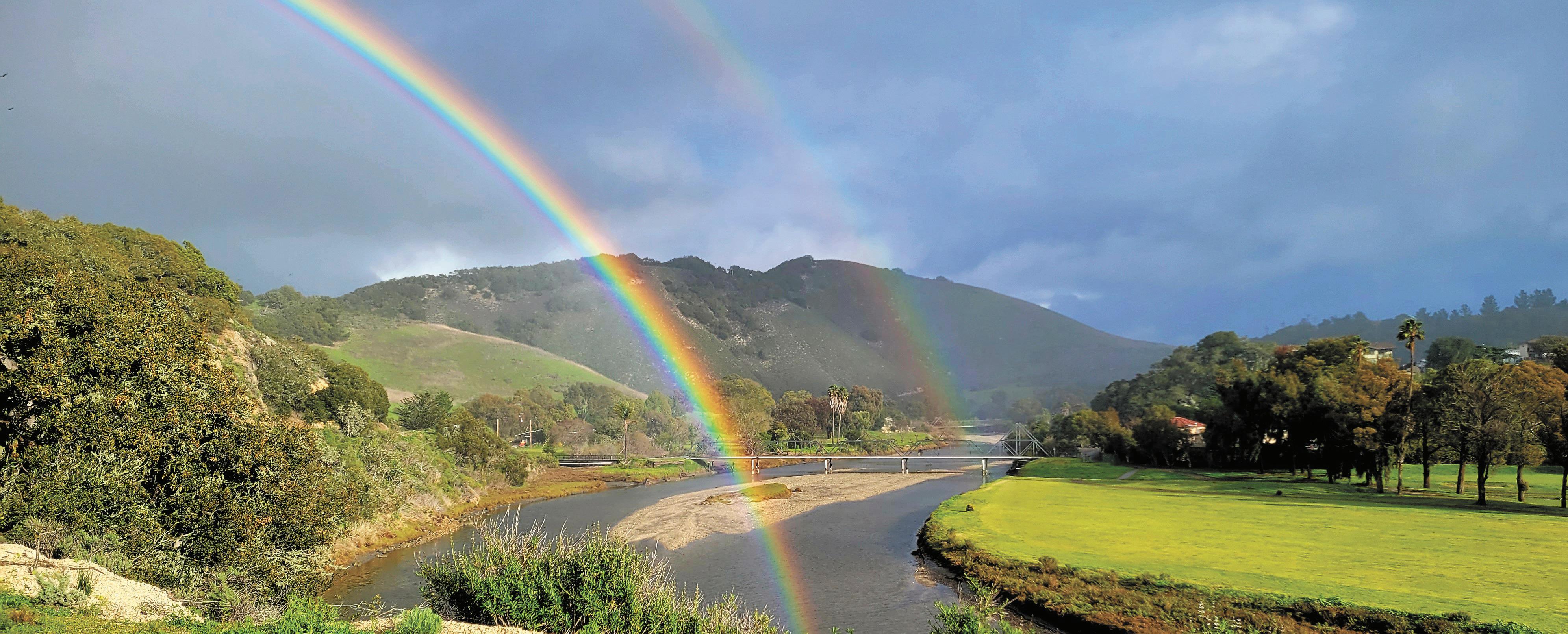
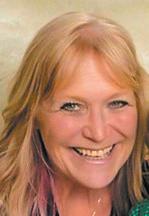
There’s an empty space in our hearts, Where you once held a place. A hollow ache that brings us to tears, Of the sadness we must face.
We will miss everything about you, Your smile, your laugh, your caring heart. We don’t know how to carry on without you, Maybe celebrating you today, we can find a start.
We will take comfort in your memory, As we reminisce of you, so special, so kind. We love you so much and will do our best, But you will never drift too far from our mind.
We can rest in the assurance of seeing you again, One day we will embrace you again in love. Until then, we know God will keep you, Peaceful and loved in his arms above.
This year the third of March marked the first anniversary when I sat by my mother’s bedside and watched her leave this world. She fought cancer for 17 months. Her fight ended that day. There is a different kind of grief when you lose a parent. For those of you who have experienced this loss, I am sure you will agree that when a loving parent has passed, there is an all-encompassing quiet sorrow.
That sorrow becomes intensified by the hollow truth that one person you’ve always trusted and who was always there for you is now gone. You will never hear the voice of the first person who guided your steps, encouraged you, and you confided in ever again in this life. Even if you were not close to your passing parent, the sense of loss is still hard to describe. An honest glimpse into your own mortality as the torch passes on to the next generation.
The thing about processing grief is no one answer works for everyone. There is no one way to make the sorrow lesson quicker. I now know one thing about grief...it takes

as long as it takes. No steps to complete, no magical words or prayers can rush the process. It just takes time. It will get better with the support and prayers from friends and family. But truthfully, losing a parent is hard. I must say that milestones are the toughest, and holidays are not easy either. Still, there is something about those dates that leave a permanent reminder that someone you love has died. Dates that stand out as a day uniquely theirs, like Mother’s Day, the day they were born, and sadly the day they died.
Remembering and honoring my mother is so important to me. I keep in weekly contact with my father, as his loss is much different than mine. He lost the love of his life. Every day is a journey of sorrow for him, missing her presence in his world. I can’t imagine his loss, just like I can’t imagine the loss of a child, which he and my mother also experienced. I came to the astounding realization that wherever you are in your grief. Own it! Take your time to deal with your loss and take the time to reminisce, hurt, cry, and even scream if
it helps. Be decisive even when you don’t feel like it, and never give up; your loved one wouldn’t want that for you. Be careful of anyone, although well-meaning, telling you it’s time for you to move on or to get past it. It takes as long as it takes, and you need to take just as long as you need. Don’t allow insensitive family and friends to dictate how you process your grief. I know my grief for my mother will get better with time.
My advice, find solace in whatever your belief system may be. If you need a friend, find one; if you need therapy, call one; and if you need a grief group, there are plenty around. Just remember to take care of yourself. Remember the beautiful memories you created with that person. Whoever they are to you, your mother, father, spouse, child, sibling, dear family member, or friend. Mourn them, remember them, honor them, and cherish their memory by loving yourself.
Finally, be gentle with yourself; grief takes as long as it takes.
Be kind to yourself and others.
For Avila Beach LifeThe 2022 California Preliminary Crush Report for winegrapes was 3,620,595 tons, down 6.7 percent from the 2021 crop. Cabernet Sauvignon surpassed Chardonnay as the largest variety with the percentage of the total tons crushed at 15.4 percent. Chardonnay was second with a percentage of 14.4 percent. The 2022 average price per ton was up 5.7 percent from 2021. It was a crazy year with some really long and hot periods of weather taking a toll on the production. As stated before, this year is starting off great with the ground saturated and flushed of toxins like salt which built up from irrigations, fertilization, and herbicides during the drought giving the roots a clean palette to expand. Growers will be able to carefully monitor what they put back into the soil to build up fertility. Let’s hope for a perfect growing season for once.


The Journal of the American Medical Association (JAMA) just released a report on February 6, 2023, which you can look up for more detailed information about the “Changes in Alcohol Consumption and the Risk of Dementia in a Nationwide Cohort in South Korea.” The question was: “Is a change in alcohol consumption associated with the

incidence of dementia?” The findings were great, at least for this 80-year-old drinker of two glasses of red wine (Old Vine Zin from Lodi or Paso Robles or interesting red blends for the most part).” Adults aged 40 years and older underwent two health examinations in 2009 and 2011. The cohort was assessed until December 31, 2018, and statistical analysis was performed in December 2021. In the cohort of a dozen South Korean doctors did an intensive study of 3,933,382 individuals in South Korea, maintaining mild to moderate alcohol consumption was associated with a decreased risk of dementia compared with sustained nondrinking, whereas sustained heavy drinking was associated with an increased risk of dementia. Reduction of drinking from a heavy to a moderate level and initiation of mild drinking were associated with a decreased risk of dementia compared with a sustained level of drinking. The number of standard drinks was converted to measurements of pure alcohol in grams depending on types of alcohol. These findings suggest that the threshold of alcohol consumption for dementia risk is low.”
It was interesting that those who quit drinking at all stages of alcohol consumption at the 2011 screening and sustained quitting were at a higher risk of all-cause dementia, vascular dementia (VaD), and Alzheimer’s (AD). I guess going “Cold Turkey” doesn’t cut it. More than 57 million people live with dementia worldwide, and this number is expected to increase to more than 152 million, three times more in only the next three decades. Alcohol consumption is generally considered a potentially modifiable risk factor for dementia, including the initiation of mild alcohol consumption. Again, look up the Jama article for a more detailed look at the findings.
A little energy news: A study by the Anderson Economic Group states fuel costs of electric vehicles overtook gas-powered cars for the first time in eighteen months. “In Q4 2022, the typical mid-priced ICE (Internal Combustion Engine) car drivers paid about $11.29 to fuel
their vehicles for 100 miles of driving. That cost was around $0.31 cheaper than the amount paid by mid-priced EV drivers charging mostly at home, and over $3 less than the cost borne by comparable EV drivers charging commercially.” The fuel cost is based on real-world driving conditions, including the cost of the underlying energy, state taxes charged for road maintenance, the cost of operating a pump or charger, and the cost to drive to the fueling station. That is not counting time spent waiting for the charge versus a quick stop at a gas fueling station. Wasn’t that interesting the other day in the news, that it took 6,000 gallons of water to put out a Tesla battery on fire? Imagine that time bomb going off in your garage.
Allysia Finley in the WSJ reports “The Climate Crusaders Are Coming for Electric Cars Too,” a new report from U.C. Davis and a “network of academics and policy experts” — doesn’t that sound scary? The report makes it clear that the ultimate goal is: tiny, uncomfortable apartments and smaller houses and yards, fewer cars, bicycles for all, and a much smaller standard of living.
Problem 1: Their reasonable position is, EV vehicle batteries require a lot of rare earth minerals that must come from the ground just like fossil fuels. These are found mostly in undeveloped countries causing environmental and social damage and many times irreversibly damaging landscapes without the will of the local inhabitants, plus the use of child and slave labor. Something I have been reporting on, ad nauseam, since last summer.
Problem 2. Also, they are reasonably concerned that mining requires lots of energy (fossil fuels for the most part) and water, plus the process of refining these elements needs even more energy which accounts for 4 to 7 percent of global greenhouse-gas emissions. Bigger SUVs and pickups, EVs of choice, mean bigger batteries and more rare earth minerals that add to the destruction of tropical forests that help suck up CO2 out of the air and store the carbon in the ground. Also, Ditto.
Problem 3. “Producing EVs and building and maintaining roads, highways, and parking lots are energy and emissions-intensive processes with high levels of embodied carbon.” The report concludes with EVs are likely incompatible with climate activists’ goals to keep the planet from warming more than 1.5 Celsius compared with preindustrial times. Here is where they lost me. The report recommends government policies that promote walking, cycling, and mass transit. Also, reduce financial subsidies for private vehicles, less funding for on-the-street and other free parking, impose charges on pickup trucks and SUVs including electric ones, and build more bicycle lanes such as downtown San Luis Obispo has done by reducing three lanes on Higuera and Marsh to two lanes, which are often one-lane when service trucks need to block a lane to unload. It would nice, I suppose if someone would use the bicycle lanes. I did see a Cal Poly student (wearing a CP shirt) on Marsh the other day going “hell-bent for leather” southbound on northbound one-way Marsh, but he was on the sidewalk.
Of course, The Natural Resources Defense Council is on board saying the government needs to “reduce long-term dependency on single-passenger vehicles” — how does that work in rural California, “flyover country,” and the wide open spaces of Texas and similar states, and for God Sakes us farmers and our farm workers just to getting to work? The Inflation Reduction Act included billions of dollars to promote bicycling and so-called livable neighborhoods meaning living in shoebox apartments in cities, preferably close to mass transit facilities, and making suburbs denser and less appealing like infilling private home properties with buildings as pushed here in this county. If all you can buy soon are EVs, even with subsidies and with the cost of the scarcity of battery parts going up, you will not be able to afford an electric vehicle, so get used to mass transit and pull out of storage that old 10-speed bike.

MAR 5: SUN WINTER WELLNESS SERIES | PILATES/ KAYAK TO THE LIGHTHOUSE

PT. SAN LUIS
10am-1:30pm
Paddle a kayak out to the amazing Point San Luis Lighthouse for a one of a kind Pilates session led by Vanessa Dominguez of Tabula Rasa Pilates!More Info my805tix.com/e/pilates-kayak/tickets
MAR 19: SUN
WINTER WELLNESS SERIES | PILATES/ KAYAK TO THE LIGHTHOUSE
PT. SAN LUIS
10am-1:30pm
Paddle a kayak out to the amazing Point San Luis Lighthouse for a one of a kind Pilates session led by Vanessa Dominguez of Tabula Rasa Pilates!
More Info my805tix.com/e/pilates-kayak/tickets
MAR 17: FRI ST. PATRICK’S DAY
MAR 27-31
SPRING BREAK SEA EXPLORER CAMP CENTRAL COAST AQUARIUM 9am-3pm
Join the Central Coast Aquarium for a fun filled week of hands-on marine science experiments, dissections, crafts, and games! Each day campers will learn about the marine life and ecosystems that make up the world’s oceans. Ages: 6 – 10 To register or for more information contact Jaclyn Mann at jaclyn@centralcoastaquarium.org or (805) 457-5357


